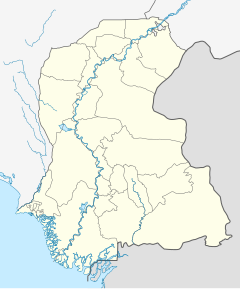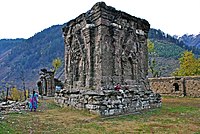Shadani Darbar
| Shahdani Darbar | |
|---|---|
 Shahdani Darbar | |
| Religion | |
| Affiliation | Hinduism |
| District | Ghotki District |
| Location | |
| Location | Mirpur Mathelo Taluka |
| State | Sindh |
| Country | |
 Shown within Sindh | |
| Geographic coordinates | 27°57′30.7″N 69°30′30.1″E / 27.958528°N 69.508361°ECoordinates: 27°57′30.7″N 69°30′30.1″E / 27.958528°N 69.508361°E |
| Architecture | |
| Type | Hindu temple |
Shadani Darbar is a historic Hindu temple in Pakistan. It is located in Hayat Pitafi, Mirpur Mathelo Taluka, Ghotki District in the Sindh Province of Pakistan.[1][2] It is said to be the biggest Hindu temple in Sindh. The temple is visited by devotees from not only Pakistan but also from India.[3]
History[]
The foundation of Shadani Darbar was laid by Sant Shadaram Sahib in 1786. The Sant Shadaram is a great Hindu saint who was born in 1708 in Lahore.[1]
Annual Celebration[]

Three day celebrations are held in the temple annually during the birth anniversary of Sant Shada ram. During these days, Agni Pooja is conducted and the recitation of Bhagavad Gita and Guru Granth Sahib takesplace. Mass wedding of poor Hindus are also conducted by the temple authorities during these days.[3] Pilgrims from India visit the temple during these celebrations.[4]
See also[]
- Ramapir Temple Tando Allahyar
- Umarkot Shiv Mandir
- Hinglaj Mata mandir
- Baba Ram Thaman Shrine
References[]
- ^ a b "Hindu pilgrims attend central ceremony of Shadani Darbar". Pakistan Today. 6 December 2018. Retrieved 23 December 2020.
- ^ "209 Hindu pilgrims arrive to attend rituals at Shadani Darbar". The News International. 6 December 2018. Retrieved 23 December 2020.
- ^ a b "Indian pilgrims accorded warm welcome in Ghotki". Express Tribune. 23 November 2016. Retrieved 23 December 2010.
- ^ "Pakistan issues visas to Indian yatrees to visit Shadani Darbar, Katas Raj temples". Hindustan times. 22 December 2020. Retrieved 23 December 2020.
- Ghotki District
- Hinduism in Sindh
- Hindu temples in Sindh
- Pakistani religious building and structure stubs


